
Acoustic guitar pickups are one of those topics that we as players rarely discuss.
Because for the most part, we’d prefer to play the acoustic guitar, well…acoustically.
Yet once you start performing, and amplification becomes necessary, you suddenly realize how important the right pickup can be, in not ruining the natural sound of your instrument.
So if you’re at this point now, you’ve come to the right place.
Because in this ultimate guide, you’re going to learn everything you need to know when comparing models, and towards the end, hear our top recommendations.
First up…
Acoustic vs Acoustic-Electric Guitars: The Key Difference
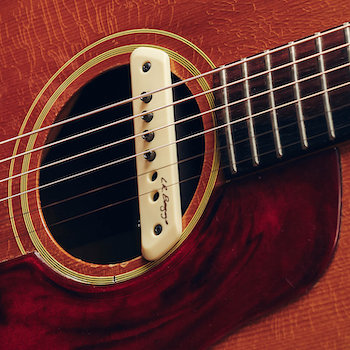
When you first start messing with acoustic pickups, you may be surprised discover how different your guitar sounds through a PA.
On one hand, acoustic-electric guitars often sound better through their pickups than they do when played acoustically.
On the other hand, your beautiful vintage guitar might have an amazing acoustic tone, yet sound awful with a certain pickup.
And this can potentially be a huge problem, for anyone looking to add their own custom pickups to their rig.
Which is why, finding the right pickup, for the right guitar, is essential in achieving a good sound.
So let’s see if we can help you out with this part.
Up next…
The Standard Tool for Amplifying Acoustic Guitars
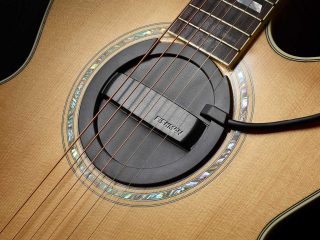
The standard, and most popular style of acoustic guitar pickup is known as magnetic soundhole pickups.
In the same way that electric guitar pickups work…soundhole pickups create a magnetic field to sense string vibrations, then send a voltage signal into the cable.
That actually sound quite similar to a clean electric guitar, since almost all the vibrations come from the strings, and almost none from the body.
Which sounds kinda bad in a way…but could be good also, if that’s what you actually want.
One big advantage of this design is that can easily installed and uninstalled, with no drilling or other modifications to the guitar itself.
While certain cheaper models may be somewhat prone to feedback on-stage, the good ones, which I’m about to show you, are mostly suitable for live-shows in mid-large sized venues.
Single-Coil:
- Seymour Duncan Woody – (Amazon/Thomann)
- Fishman Pro Neo D01 – (Amazon/Thomann)
- Dean Markley SC-1 – (Amazon/Thomann)
Humbucker:
- Seymour Duncan Woody HC – (Amazon/Thomann)
- Fishman Rare Earth – (Amazon/Thomann)
- Fishman Pro Neo D02 – (Amazon/Thomann)
- Dean Markley Pro Mag – (Amazon/Thomann)
Active:
Up next…
The Pickup That’s MOST Resistant to Feedback
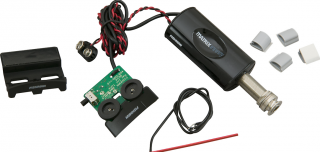
A common complaint with acoustic guitar pickups is that they are vulnerable to feedback in loud performances.
Undersaddle pickups however, which are mounted beneath the bridge of the guitar, are more resistant to feedback than any other design.
Using piezo-electric technology…these pickups use a strip of crystals guitar to sense vibration pressure beneath the bridge.
Just like with magnetic soundhole pickups, they “hear” ONLY the strings, and none of the body.
In this case though, since the vibrations are caught at the end of the strings, rather than the middle, they have a brighter, thinner sound, with a stronger attack.
Because of the small voltage generated, they also require a preamp to boost the signal.
One potential problem is their excessively wide dynamic range, where:
- 2x pressure = 4x volume
- 1/2 pressure = 1/4 volume
To compensate, the paired preamps often use a compressor to even-out levels. Although the sound of this compression can be quite noticeable at times.
Two other downsides worth noting are:
- Pro Install Required – although modifications are minimal.
- Piezo Quack – which is a weird sound artifact you may get from cheaper designs
But if you find that overall, this mix of pros and cons suits your needs, here are the models I recommend:
- Fishman Matrix Infinity – (Amazon/Thomann)
- Fishman Saddle – (Amazon/Thomann)
- LR Baggs Element – (Amazon/Thomann)
Up next…
A Piezo Pickup Design With Way More Flexibility
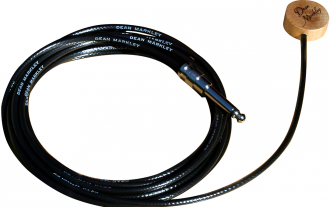
Commonly known as either contact pickups or bottle caps, soundboard transducer pickups are similar to the previous design we covered…
Except they can be mounted almost anywhere, like under the bridge, inside or outside the body, or wherever.
And installation is insanely simple. All you need to do is attach the sensor temporary adhesive that can be easily removed without damage to the finish.
Compared to undersaddle pickups which only sense the strings, soundboard transducer pickups sense vibrations from both the strings and body, resulting in a more naturally balanced sound.
For anyone incorporating percussive techniques into their playing, these pickups are really the only option worth considering.
The biggest downside is that it is quite sensitive to feedback, and can be difficult to use in louder settings with multiple instruments.
If all these features are what you’re looking for, here are the models I recommend:
- Dean Markley Artist Transducer – (Thomann)
- Fishman SBT-E – (Amazon/Thomann)
- K&K Pure Mini – (Amazon/Thomann)
- C-Ducer CQS8 – (Thomann)
Up next…
The Acoustic Guitar Pickup with the Highest Sound Quality
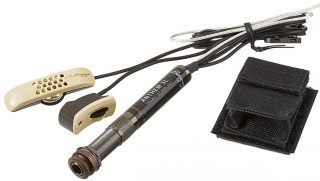
Compared to the previous pickup designs we’ve covered, microphone pickups have the best sound quality by far…
Since they are essentially a high-quality miniature microphone that mounts inside the body of your guitar.
Since they have the widest frequency range, they’re great at preserving the natural tonal balance of the instrument.
On the other hand, they’re also expensive, in both the cost of the pickup itself, AND the cost of the professional installation.
They’re also MOST prone to feedback…and are usually only usable for solo acts, and small quiet venues.
If this mix of pros and cons suits you, here are the ones I recommend:
Up next…
An Acoustic Guitar Pickup that Offers the Best of Both Worlds?
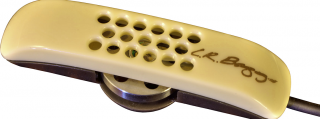
Of the acoustic guitar pickups we’ve so far…each clearly has its own set of major pros, and major cons, right?
One might sound better, but be more prone to feedback, and another might do the exact opposite.
But wouldn’t it be great if you could somehow have the best of both worlds? Well as it turns out, you kinda can.
Because many of the most expensive pickups use blended designs that combine a high-quality microphone with one of the other piezo-based sensors.
The two inputs are then either combined into a single output, or given a separate output for each source.
Here are two of the top models to check out:
Now that we’ve covered all major options with acoustic guitar pickups, here’s one final thought I’d like to conclude with…
Can Acoustic Guitar Pickups Work Well in the Studio?
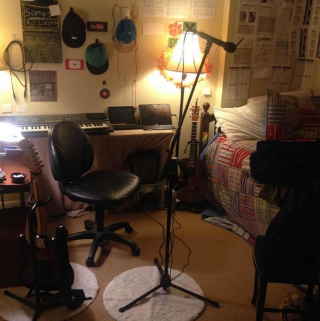
If you’re like most musicians today…you probably have at least some version of a half-assed studio setup in your home.
And you might be wondering to yourself: Can I use these pickups for recording?
Well the answer is, you CAN. And some ways, it can even have its advantages over traditional microphone setups.
While they won’t have the potential to capture that same “full” sound you could get…
- with a pair of nice condenser mics
- in a room with proper acoustic treatment…
The reality is that most home studio owners don’t have most of this stuff anyway. And even among those who do…unless executed properly, the recording can still turn out pretty bad.
With acoustic pickups though, everything is simple. You just plug in and record. And if you’re one of those players who likes to move around a lot, it’s okay, because the pickup moves with you.
While the end result won’t ever compare to a true studio recording…
In many cases, especially with denser mixes, you really don’t need the full sonic spectrum of the instrument anyway. So it doesn’t even matter.
By the way, if you found this post useful, I highly recommend joining our free Home Recording Secrets email newsletter where you’ll discover….
- How to Get Your First Studio Up and Running in a Single Weekend
- How to Avoid Wasting Thousands of Dollars on Unnecessary Pointless Purchases
- How to Get a “Million Dollar” Pro Studio Sound in a “Thousand Dollar” Home Studio
- PLUS… All Sorts of Other Amazing Insider Secrets Revealed
And it’s totally FREE! Click here and Enter Your Email to Sign Up.
More Guitar Posts in This Series:
Electric Guitar | Acoustic Guitar | Bass Guitar | Amps | Pedals | Cables | Pickups | Bass Strings | Bass Amps | Bass Pickups | Classical Guitars | Acoustic Pickups | Direct Boxes | Cases | Picks | Slides | Straps | Tuners | Stands | Strings | Capos | Tabs | Guitar Accessories